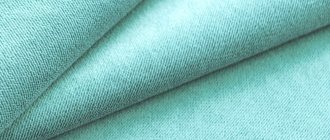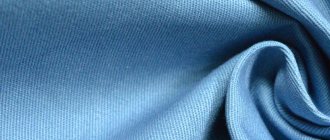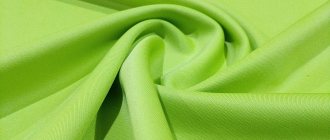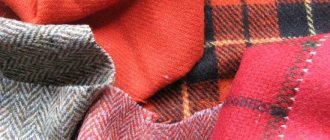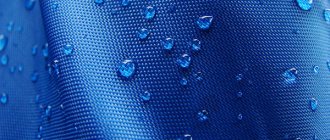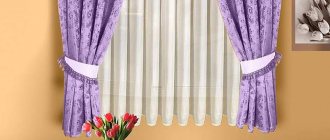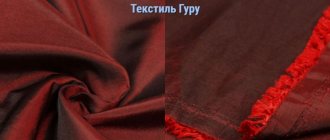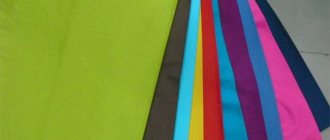A little history
The once unique technology of chemical etching, in which devoré fabric takes on a sophisticated, elegant look, is now used by many manufacturers and is becoming popular, but many still do not know what it is.
Devore first became known at the end of the 19th century, when a beautiful material similar to lace fabric began to be created in factories in the French city of Lyon. The material created in this way was considered exquisite and expensive at that time; it was made on the basis of velvet and silk; festive outfits were sewn from it for royalty and rich people. The advent of synthetic fiber gave this technique a rebirth.
The idea of using devoré on fabrics woven from artificial threads turned out to be so successful that a new technological production based on various materials was developed. Now there is a large selection of original fabrics with an “etched” surface, various textures and colors at a very affordable price.
What is Devore?
Devore is not a special material, but an etching technique with which fabric acquires patterns on a transparent background. The essence of the method is the chemical burning of individual areas, due to which a pattern appears on the material.
Description of the stages of etching technology:
- an outline is applied to the fabric fabric, which will be etched;
- the reverse side is impregnated with a chemical substance that protects the rest of the material from burning;
- Special gels are applied to the sketch to etch the fiber;
- Using a soda solution, chemicals are removed from the fabric.
The reagent used is a substance that contains aluminum sulfate and sodium biosulfate. They are a viscous gel that dissolves the cellulose fibers that make up the material.
Modern technologies offer 3 methods of fiber etching:
- chemical - using reagents;
- electromechanical – under the influence of an electric field;
- dry – ion plasma, in which the fiber atoms undergo ionization.
How safe is it to wear items made from devoré fabric? Many people are concerned about this issue, because the canvas is exposed to potent substances. However, a soda solution completely neutralizes such aggressive reagents, and such clothes can be worn even by children.
This is interesting: Grodetour fabric: the advantages of clothes of the Middle Ages
Production Features
Devore is a complex chemical etching technique that gives fabric a magnificent, truly magical look. An exquisite satin or velvet design literally floats on a matte or transparent background, and the material becomes light, vibrant and voluminous.
As mentioned above, devore is a fabric with a special surface texture obtained by chemically burning out part of the fibers. When devore was made only from silk (smooth or fleecy, velvet). Modern fabrics contain mainly polyester and viscose. As a result, the material has become significantly cheaper, but has not lost its main highlight - its original and attractive appearance. The more expensive Devore is made from natural (cotton and linen) and mixed fibers. But the most expensive and in demand fabric is still considered to be one based on natural silk.
The photo shows chiffon made using etching technology,
Organza Devore is one of the most popular curtain fabrics.
Today, most modern devoré materials are organza, consisting of 70% polyester (warp thread) and 30% viscose (weft thread).
The essence of the etching technique is that individual sections of the finished fabric are burned out with specially selected chemical reagents, resulting in a fabric with alternating dense and transparent sections.
Devore production consists of the following stages:
- A specially prepared sketch is applied to the canvas.
- A protective compound is applied to the backside to etch out areas strictly according to the sketch, but not to damage the rest of the material.
- Then the etching procedure is carried out. Under the influence of chemicals, the selected layers are destroyed and the desired pattern is formed. Reagents are selected for each material separately.
- The canvas is washed in a soda solution, all chemicals are removed.
- After etching, additional designs can be applied to the canvas.
Devore technology is considered environmentally friendly, since the soda solution neutralizes all harmful components and makes the fabric safe for health.
The etching process itself comes in three types:
- Liquid (burning with chemical reagents).
- Electromechanical (an electric field is applied to the canvas).
- Dry (ion plasma).
Fabrics of any texture and fiber composition - satin, silk, velvet, velor, chiffon, organza - can be etched.
Depending on the artistic intent, the canvas can be painted in different colors and have a variety of prints. One of the most exquisite methods of decoration is hand painting.
How is devoré made?
This exquisite and unusual fabric is produced using an unusual and complex technological technique - chemical etching. When the fibers of the fabric interact with the etching agent, a chemical reaction occurs. It completely or partially dissolves cellulose, which is part of viscose, cotton, flax or fibrinoin - the protein components of silk. The best result of such etching is obtained on materials with different compositions of warp and weft threads. Most modern devoré materials are of the organza type, in their original state they contain 70% polyester (warp) and 30% viscose (weft) . Etching is carried out in the following sequence:
- a special protective agent is applied to the reverse side in accordance with the drawing so that it forms a mask that protects against the penetration of the etching reagent;
- the material prepared in this way is placed in an etching composition based on aluminum sulfate or sodium biosulfate (or the underside of the canvas is lubricated with an etching gel) and, if necessary, heated;
- after etching, the fabric is washed and the remaining reagent is washed off with a soda solution;
- if necessary, additional print is applied to areas that have not been etched.
Related article: How to sew felt tulips
As a result, the polyester fibers remain unchanged and form a uniform translucent background in the etched areas. The areas remaining under the mask create a beautiful pattern with a spectacular play of light, giving the fabric movement and a voluminous effect. The etched design may be repeating or arranged as a coupon of a specific size.
The bulk of devore that goes on sale is produced industrially. Such production requires high-tech equipment that will ensure very accurate reproduction of the design without deviations and contours (which are common on inexpensive materials). When purchasing devore made from synthetics and viscose, you should remember that after etching the viscose, its percentage in the fiber decreases, and the material will become almost completely synthetic. Exclusive fabric with original coupon painting is made by hand by craftswomen using mixed or natural fabrics. Using manual etching technology, artistic panels, original curtains and other unique interior decoration items are created, as well as material for creative designer outfits.
The most expensive and refined is devoré silk, which is used for unique designer outfits or luxury interior decoration.
Benefits of Devore fabrics
Devore silk is one of the most expensive and exclusive natural materials.
Etched silk fabric.
Using this technology, curtain fabrics of various compositions are produced.
Devore velvet looks incredibly luxurious and mesmerizing.
Since Devore is not inherently a type of fabric, but a special type of surface on a certain type of fabric, each of them has the advantages of its own “family”, to which is added an unusual surface texture.
Devore, based on viscose and polyester, belonging to the tulle fabric family, has the following advantages:
- UV resistance (does not fade in the sun);
- strength and wear resistance (last for many years);
- easy care (easy to wash and dry quickly).
Devore based on natural (silk, cotton and linen) fibers retain all the advantages of natural materials:
- hygroscopicity (they absorb and evaporate moisture well);
- hygiene (“breathe” and do not interfere with free heat exchange).
Devore properties
Despite the fact that during etching the fabric is partially destroyed and looks thin and airy, in practice it is durable and not at all difficult to care for. Devore, based on synthetics and viscose, which is classified as tulle materials, has the following properties:
- durability;
- mechanical strength;
- UV resistance;
- easy to wash and iron (machine washable at 30 degrees).
As for natural materials, even after etching they retain such advantages as
- thermal conductivity,
- hygiene,
- low allergenicity.
The production of devore, like this material itself, can be classified as an environmentally friendly technology, since treatment with soda solution neutralizes all harmful ingredients and makes this material absolutely safe . As for washing, it is better to have unique hand-painted silk or velvet fabric, as well as products made from it, for professional cleaning. As a last resort, it can be carefully washed by hand, without twisting and using the most delicate products. The washed product should be well straightened and dried in the shade, then ironed from the inside out with a warm iron. As for cotton and linen, they are washed and ironed in the same way as regular products with this composition, although the most preferable mode for them is delicate washing and ironing from the inside out.
Article on the topic: Magazine “Irene” No. 5 2019
Areas of use
Despite the fact that such materials look thin and delicate, etching gives them strength and allows them to be successfully used for sewing beautiful, wear-resistant clothing and home textiles (curtains, bedspreads, pillows).
The main areas of application of Devore fabrics are sewing elegant clothes and designer curtains for decorating luxury interiors.
Women's clothing is mainly made from fabric with an etched surface, mainly wedding, cocktail and evening dresses, skirts, blouses and cardigans. All Devore items are light and airy, do not restrict movement, and successfully emphasize the dignity of the figure.
Designers prefer to sew models from devore with a distinctly simple cut, so as not to distract attention from the exquisite pattern on the fabric.
It is impossible to take your eyes off evening dresses made using the devoré technique.
It is practically not used for sewing men's clothing. The exception is the concert costumes of pop stars and circus performers.
Tulle and devore curtains seem to be specially created for luxurious interiors, decorated in the classic styles of past centuries.
The technique of making devoré fabric is successfully used in the production of tulle. Graceful floral patterns and elegant arabesques look perfect on a transparent base. The ability to choose tulle with different patterns, differing in shape and color, makes it truly versatile. Such curtains add airiness and lightness to the interior, filling its atmosphere with soft natural light, as if sifted through an invisible sieve. They fit best in luxurious or romantic styles, such as:
- baroque;
- rococo;
- Empire;
- Provence;
- Mediterranean;
- Scandinavian;
- and the like.
The textile industry produces curtains in the form of original tulle or curtain mesh with various patterns, organza using the devoré technique, nylon with a multi-colored pattern, transparent cambric with a woven pattern.
Bed linen made from devore satin is considered elite.
Such sleeping sets are just conquering the market, but have already become very popular.
A special area of using the technique of artistic fabric etching was the production of bed linen from devore satin. Such sleeping sets have all the advantages of natural cotton products, they are durable, hygienic, easy to care for and at the same time exquisitely beautiful. Today they outsell even the trend of recent years - duvet covers and pillowcases with 3D printing.
In addition, decorative panels, napkins, capes and other elegant home textiles for exclusive interior decoration are becoming increasingly popular.
Features of the etching method
Devore fabric for curtains
The essence of etching is the controlled removal of a certain layer of material. For the procedure, special reagents are selected that are suitable for the textile being decorated. In general, this technique is used in metallurgy and electronics. The following types of etching are distinguished:
- liquid (using chemical reagents);
- electromechanical (they apply an external electric field to the material);
- dry (ion-plasma, when atoms undergo ionization).
The fabric is “burned out” according to a special sketch to create the intended design. For textiles, chemical compounds are used, that is, liquid etching. The devoré technique is used for the following types of fabric:
- Velvet is a soft fleecy fabric based on viscose, wool, cotton or synthetic fibers. The material is obtained by cutting interconnected base sheets.
- Velor is a textile substitute for natural leather. Velvety, soft, single-sided fabric made from wool, cotton, silk and synthetics.
- Satin is a smooth material with a glossy surface, which is made from natural silk, cotton, viscose or synthetic fibers.
- Satin is a silky dense fabric with a soft shine. Made from pure cotton, sometimes mixed with synthetic threads to improve characteristics and properties.
- Nylon is a synthetic polymer fabric, light, durable and smooth.
- Chiffon is a transparent thin fabric made from twisted crepe threads, slightly textured to the touch.
- Organza is a rigid transparent material made from twisted threads of silk, viscose or polyester.
When making devore, cellulose is etched out, which is found in the plant fibers of flax, cotton and viscose (which, in fact, is processed from cellulose). The most effective fabrics are obtained when the warp and weft threads are of different types of fibers by origin.
Devore - “female” fabric
Synthetic threads, such as polyester polyester, are also acceptable in devore. Then the natural threads are etched away, and synthetics remain, making the fabric as wear-resistant as possible. The most expensive type of material is considered to be etched natural silk.
For etching fabric, a gel containing aluminum sulfate and sodium bisulfate is used - this is a viscous substance that is applied to the underside of the fabric. When a chemical reaction occurs, the cellulose dissolves, turning the fabric into a weightless veil. Untouched matter presents a clear pattern.
If necessary or according to the artistic design of the manufacturer, the top of the devore can be additionally painted and colored prints applied. The most exquisite way of decoration is hand painting.
How to care
Despite the external thinness and fragility, the products are easy to care for. It is recommended to look at the label for the specific material for detailed care instructions:
- It is better to wash Devore clothes by hand, after a short soaking;
- bulky home textiles (curtains, bedspreads, tablecloths) can be machine washed;
- when washing automatically, the delicate mode is usually selected and the water temperature is 30-40°C;
- washed items are carefully straightened out and dried away from heating devices (items on hangers, tulle directly on the curtain rod);
- It is preferable to iron any products from the wrong side in a mode appropriate to the type of fabric.
Delicate and exclusive items (very thin or with hand embroidery, sequins) are best taken to a professional dry cleaner.
Easy care
izdelia-7
izdelia-8
Products made from Devore are not difficult to care for.
- They tolerate washing well in the gentle cycle of the washing machine. The water temperature should not exceed 30
OWITH.
- Dry the items flat and iron them with a low-heat iron with a removable platform on the reverse side.
Devore effect fabrics are extremely interesting. They were used to decorate themselves with courtiers in the 19th century and ladies of high society in the 20th century.
Today, transparent curtains with delicate patterns have taken root in the interiors of city apartments and country houses.
Nowadays, it is still an expensive and refined material for select people and for special occasions. A stunning outfit will make you feel like a queen at any party.
Characteristics of Devore Matter
Devore is obtained by etching the fabric base. As a result, the material acquires a convex pattern. This treatment is not suitable for all types of fabric. For example, pickling is absolutely not suitable for wool.
Depending on the base used, devore can be:
- transparent;
- semi-translucent;
- matte.
The pattern on the material also differs. The patterns can look velvet or satin depending on the type of fabric. The devoré technique is so original that it is difficult to confuse this canvas with any other. Having met him once, the next time you will easily recognize him.
The pattern in this technique turns out to be more interesting if threads of different composition are taken for the weft and warp. During the processing of the fabric, some of the fibers are removed; the untouched areas make up the required pattern. The name of the technique “dévor” comes from the French language (dévorer) and is translated as “burning out”.
